|

On eBay Now...
DIOPTASE WULFENITE Specimen Crystal Cluster Mineral Emerald Green CONGO For Sale
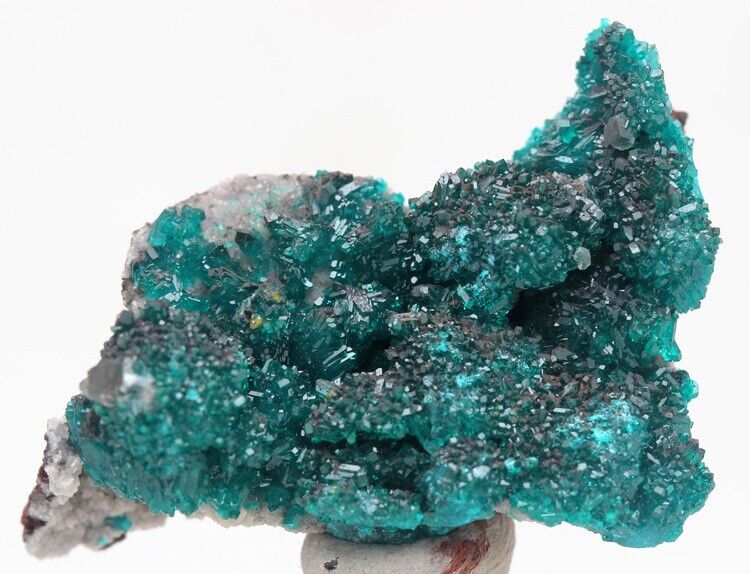
When you click on links to various merchants on this site and make a purchase, this can result in this site earning a commission. Affiliate programs and affiliations include, but are not limited to, the eBay Partner Network.

DIOPTASE WULFENITE Specimen Crystal Cluster Mineral Emerald Green CONGO:
$259.99
Click HEREto see hundreds of other amazing items for sale in my store!
This specimen weighs 11.89 grams. It measures 39 mm x 28 mm x 17 mm.
I offer a shipping discount for customers who combine their payments for multiple purchases into one payment!
The discount is regular shipping price for the first item and just 50 cents for each additional item!
To be sure you get your shipping discount just make sure all the items you want to purchase are in your cart.
sales you win are added to your cart automatically.
For any \"buy it now\" items or second chance offers, be sure to click the \"add to cart\" button, NOT the \"buy it now\" button.
Onceall of your items are in your cart just pay for them from your cart andthe combined shipping discount should be applied automatically.I offer a money back guarantee on every item I sell.
If you are not 100% happy with your purchase just send me a message to let me know
and I will buy back the item for your full purchase price.Hi there. I am selling this amazing dioptase with wulfenite specimen! It is vivid, and perfect! This is one of the most beautiful little specimens I have ever seen! It is from Kimbedi, Brazzavile, Congo. If you have any questions, do not hesitate to ask me.Have fun offerding, thanks so much for visiting my sale and have a great day!
DioptaseFrom Wikipedia, the free CyclosilicatesFormula(repeating unit) CuSiO3·H2OStrunz classification 9.CJ.30Crystal system TrigonalCrystal class Rhombohedral (3)H-M Symbol: (3)Space group R3Unit cell a = 14.566, c = 7.778 [Å]; Z = 18IdentificationColor Dark blue green, emerald greenCrystal habit Six sided prisms terminated by rhombohedrons to massiveCleavage Perfect in three directionsFracture ConchoidalTenacity BrittleMohs scale hardness 5Luster VitreousStreak GreenDiaphaneity Transparent to translucentSpecific gravity 3.28–3.35Optical properties Uniaxial (+)Refractive index nω = 1.652 - 1.658 nε = 1.704 - 1.710Birefringence δ = 0.052References [1][2]Dioptase is an intense emerald-green to bluish-green copper cyclosilicate mineral. It is transparent to translucent. Its luster is vitreous to sub-adamantine. Its formula is CuSiO3·H2O (also reported as CuSiO2(OH)2). It has a hardness of 5, the same as tooth enamel. Its specific gravity is 3.28–3.35, and it has two perfect and one very good cleavage directions. Additionally, dioptase is very fragile and specimens must be handled with great care. It is a trigonal mineral, forming 6-sided crystals that are terminated by rhombohedra.
Contents [hide]1 History2 Occurrence3 Use4 Gallery of dioptase mineral specimens5 See also6 ReferencesHistory[edit]Dioptase was used to highlight the edges of the eyes on the three Pre-Pottery Neolithic B lime plaster statues discovered at \'Ain Ghazal known as Micah, Heifa and Noah.[3] These sculptures date back to about 7200 BC.[3]
Late in the 18th century, copper miners at the Altyn-Tyube (Altyn-Tube) mine, Karagandy Province, Kazakhstan[2] thought they found the emerald deposit of their dreams. They found fantastic cavities in quartz veins in a limestone, filled with thousands of lustrous emerald-green transparent crystals. The crystals were dispatched to Moscow, Russia for analysis. However the mineral\'s inferior hardness of 5 compared with emerald\'s greater hardness of 8 easily distinguished it. Later Fr. René Just Haüy (the famed French mineralogist) in 1797 determined that the enigmatic Altyn-Tyube mineral was new to science and named it dioptase (Greek, dia, \"through\" and optos, \"visible\"), alluding to the mineral\'s two cleavage directions that are visible inside unbroken crystals.
Occurrence[edit]Dioptase is an uncommon mineral found mostly in desert regions where it forms as a secondary mineral in the oxidized zone of copper sulfide mineral deposits. However, the process of its formation is not simple, the oxidation of copper sulfides should be insufficient to crystallize dioptase as silica is normally minutely soluble in water except at highly alkaline pH. The oxidation of sulfides will generate highly acidic fluids rich in sulfuric acid that should suppress silica solubility. However, in dry climates and with enough time, especially in areas of a mineral deposit where acids are buffered by carbonate, minute quantities of silica may react with dissolved copper forming dioptase and chrysocolla.
The Altyn Tube mine in Kazakhstan still provides handsome specimens; a brownish quartzite host distinguishes its specimens from other localities. The finest specimens of all were found at the Tsumeb Mine in Tsumeb, Namibia. Tsumeb dioptase is transparent and often highly sought after by collectors. Dioptase is also found in the deserts of the southwestern US. A notable occurrence is the old Mammoth-Saint Anthony Mine near Mammoth, Arizona where small crystals that make fine micromount specimens are found. In addition, many small, pale-green colored crystals of dioptase have come from the Christmas Mine near Hayden, Arizona. Another classic locality for fine specimens is Renéville, Congo-Brazzaville. Finally, an interesting occurrence is the Malpaso Quarry in and near Agua de Oro Argentina. Here tiny bluish-green dioptase is found on and in quartz. It appears at this occurrence, dioptase is primary and has crystallized with quartz, native copper, and malachite.
Use[edit]Dioptase is popular with mineral collectors and it is occasionally cut into small emerald-like gems. Dioptase and chrysocolla are the only relatively common copper silicate minerals. A dioptase gemstone should never be exposed to ultrasonic cleaning or the fragile gem will shatter. As a ground pigment, dioptase can be used in painting.
The most famous (and expensive) dioptase mineral locality is at Tsumeb, Namibia.[4]


DIOPTASE WULFENITE Specimen Crystal Cluster Mineral Emerald Green CONGO $259.99

DIOPTASE WULFENITE Specimen Crystal Cluster Mineral Emerald Green CONGO $349.99
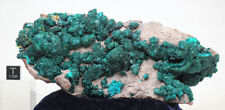
DIOPTASE WULFENITE Crystal Cluster Emerald Green Mineral Specimen Museum Quality $3199.99

DIOPTASE WULFENITE Specimen Crystal Cluster Mineral Emerald Green CONGO $149.99
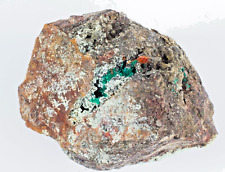
Dioptase, Wulfenite: Mammoth St. Anthony MIne, Tiger, Pinal Co., Arizona $25.00
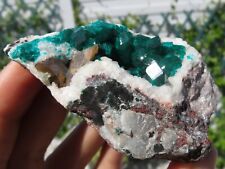
Minerals Dioptase Green With Wulfenite Namibia $3785.25
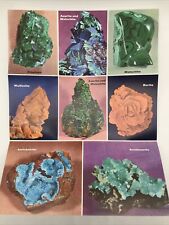
1965 ARIZONA MINERAL MUSEUM Dioptase Azurite Malachite Wulfenite Barite Brochure $8.75
|